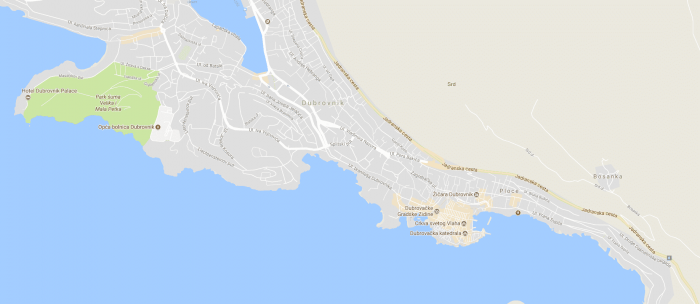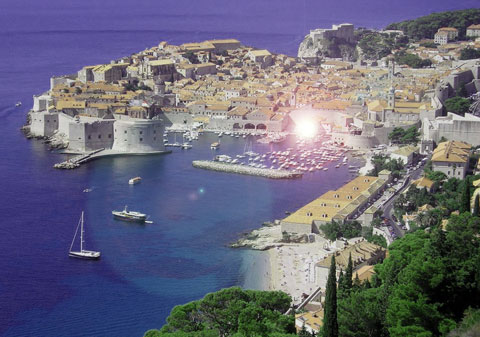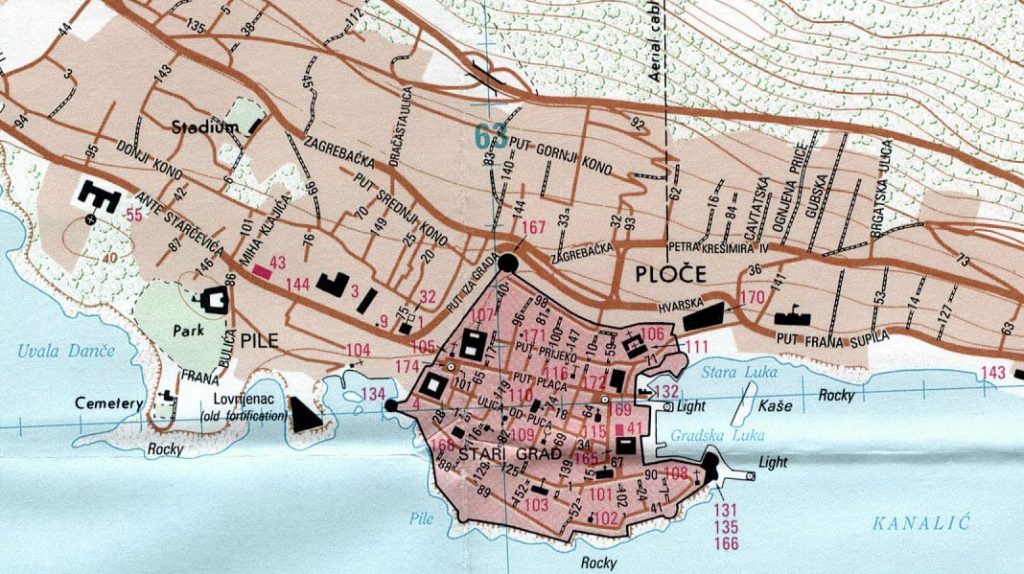
Things to do in Dubrovnik Croatia
- Walk Dubrovnik’s fortified walls.
- Daytrip to Lokrum Island.
- Find the amazing bar Buža.
- Visit the Cathedral of the Assumption.
- Take the cablecar to Srđ.
- Visit a medieval pharmacy.
- Watch the mayhem of the Midday pigeon feeding.
- Visit St Blaise’s Church.
- Try to be there during Carnival.
- Drink the refreshing water from Onofrio’s Fountains, it’s free and delicious.
 The deep blue of the Adriatic Sea seems to make the red-tiled roofs looking over it stand out from the pale masonry of the buildings and cliff-side even more. While the Citadel fortress rising high above the water and the surrounding medieval walls of this ancient city may seem imposing, this jewel in the Mediterranean known as Dubrovnik has long been a popular travel destination. When looking at a map of Dubrovnik, you can see why maritime trade has always been an integral part of commerce here. The sea defines this beautiful spot. Most likely founded by the ancient Greeks, it was a major seaport that rivaled Venice until Napoleon’s conquest of the city in 1809. War in the 1990’s damaged buildings in the city, but there has since been a resurgence of tourism and the city has been restored to its former splendor. The official name Dubrovnik was declared in 1918 but it has been known as that since the Middle Ages – although, the Italians refer to it as Ragusa.
The deep blue of the Adriatic Sea seems to make the red-tiled roofs looking over it stand out from the pale masonry of the buildings and cliff-side even more. While the Citadel fortress rising high above the water and the surrounding medieval walls of this ancient city may seem imposing, this jewel in the Mediterranean known as Dubrovnik has long been a popular travel destination. When looking at a map of Dubrovnik, you can see why maritime trade has always been an integral part of commerce here. The sea defines this beautiful spot. Most likely founded by the ancient Greeks, it was a major seaport that rivaled Venice until Napoleon’s conquest of the city in 1809. War in the 1990’s damaged buildings in the city, but there has since been a resurgence of tourism and the city has been restored to its former splendor. The official name Dubrovnik was declared in 1918 but it has been known as that since the Middle Ages – although, the Italians refer to it as Ragusa.
Dubrovnik experienced a surge of renaissance-like wealth and progress during the 15th and 16th centuries. Along with the development of its culture and arts, it became involved in world diplomacy. This included reaching a trade agreement with the colonists during the American Revolution. The city became a vacation destination in the 19th century with the building of big luxury hotels such as the Hotel Imperial. The history of this ancient city in Croatia can be seen in its buildings and architecture. Saint Blasé or Sveti Vlaho is the patron saint of the city and statues to him are numerous as well as there being a celebration in his honour with parades and parties that last several days. While Dubrovnik can boast somewhat typical Mediterranean weather, there are some phenomena that set it apart from other places in the region. Typically warm summers with temperatures in the 70’s and 80’s Fahrenheit are often interrupted by thunderstorms and while the winters aren’t extremely cold – they are windier than most locals in the Mediterranean.
The tourist trade is alive and well in Dubrovnik with the lure of the sea and the history and culture of this scenic city drawing people from around the world. The steep hillside behind Old Harbour slopes down to beautiful Banje Beach just outside of the city walls, which offers sand and some stone but also azure sparkling water. There are several other beaches available but Banje is the closest to the city. Stradun, Dubrovnik’s main thoroughfare, is edged by marble statues and offers plentiful shopping and dining opportunities. Today, accommodations range from 5 star luxury hotels to more reasonable places to stay outside of the Old Town itself. For the more adventurous, there is camping available on the peninsula as well as youth hostels and private apartments. Walking the walls surrounding the city is both easy and a wonderful way to feel the history and culture of Dubrovnik. You can spend days exploring the Old Town portion and getting a feel for its storied past.

The many museums and churches offer the history buff a remarkable look back in time. Opportunities to take a guided tour are available, as well as a pass you can purchase that gives you access to the historical sites and transportation on the city operated buses. Surrounding islands offer day trip opportunities with ferry service from Dubrovnik. Panoramic views from various buildings around the city help give this Mediterranean paradise its reputation as a top travel destination spot and a welcome port for cruise ships. Among the many sites to visit are Rector’s Palace, Minceta Tower and Arboretum Trsteno – the oldest arboretum in the world dating to the 1400’s. Whether you are looking to soak up the sun or some medieval history, the beaches and walking tours are available. If you are a fan of the outdoors, then kayaking and snorkeling in the Adriatic are there for you. After dark, the city comes alive with a vibrant night-life offering clubs, casinos and the opportunity to listen to any kind of music you like.
Dubrovnik is simply a place you cannot miss when on a trip in the Mediterranean. From its medieval walls and beautiful architecture to the stunning beauty of the sea bounding it, it is no wonder Lord Byron referred to Dubrovnik as “the pearl of the Adriatic”. The city became an UNESCO World Heritage site in 1979. Visitors flock here every summer when they hold the Annual Dubrovnik Summer Festival. This runs for more than a month and celebrates the history and cultural activities of the city with performing arts such as opera, dance, theatrical plays and concerts. Art displays, games and folklore activities are also a part of the city-wide celebration. Travel to this Croatian gem is easy since it has its own international airport as well as being a port of call for many cruise lines. From your very first view of the great wall and red roofs to enjoying the natural beauty of its beaches and water, you will be enchanted by the Croatian city of Dubrovnik.
